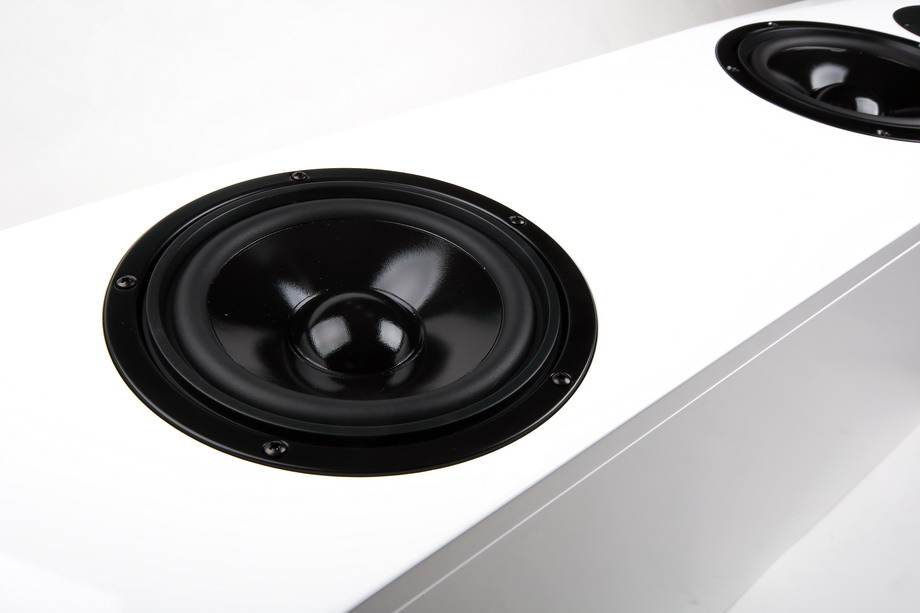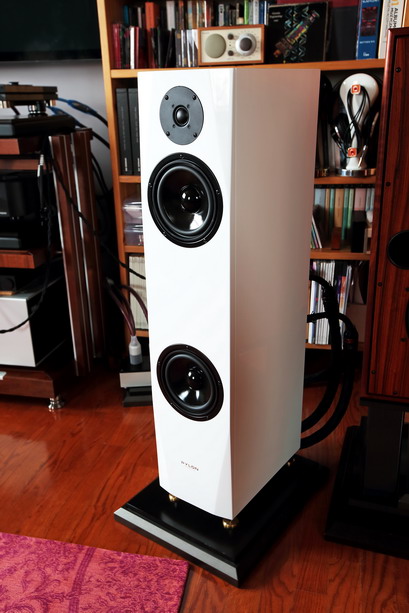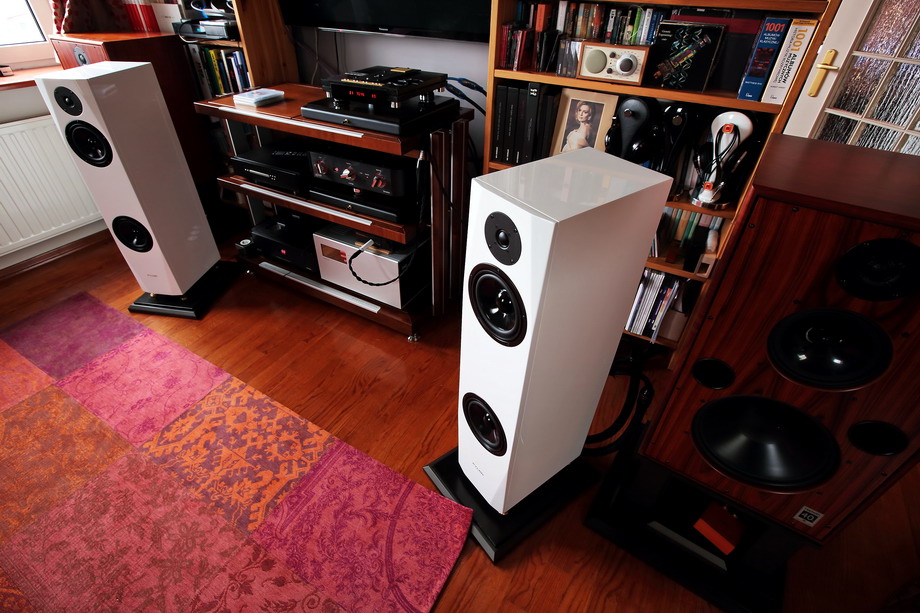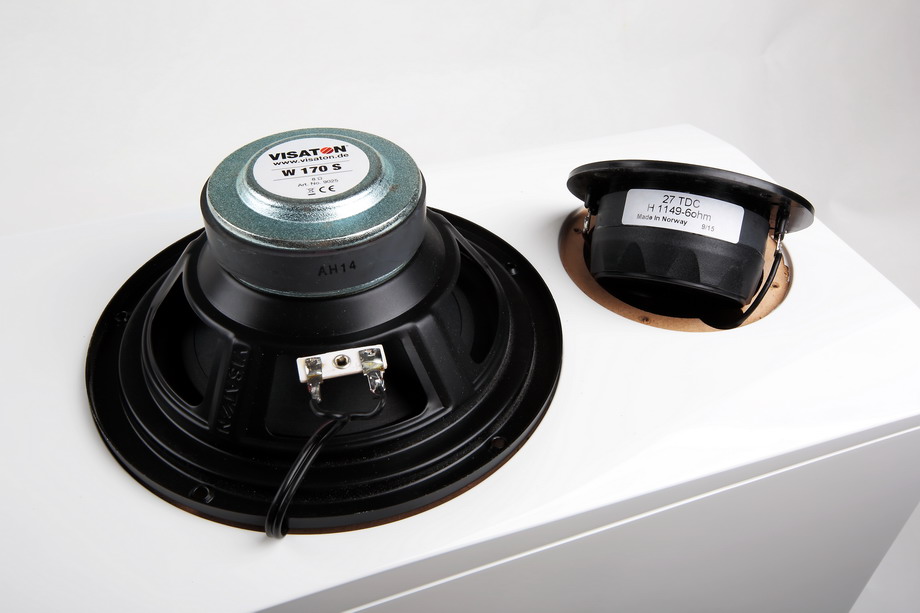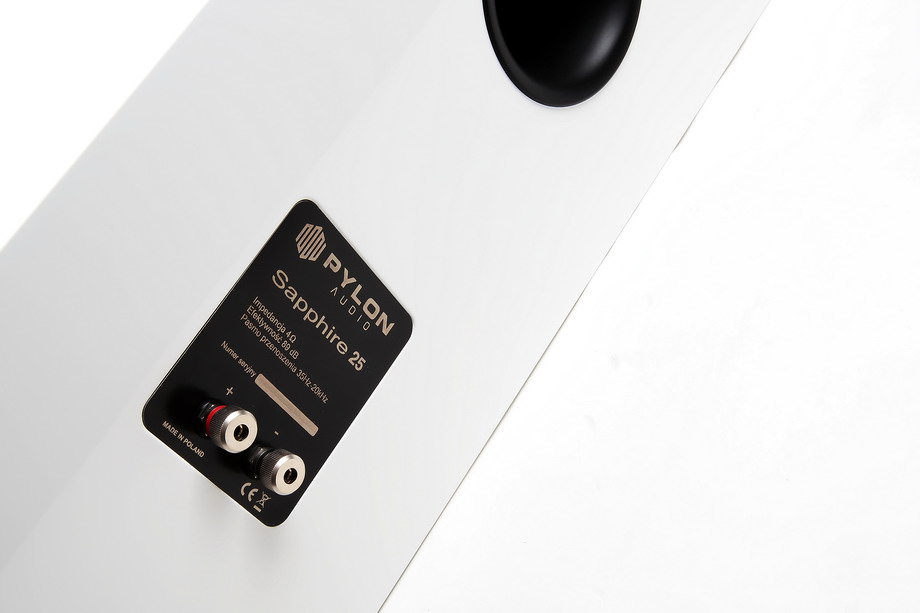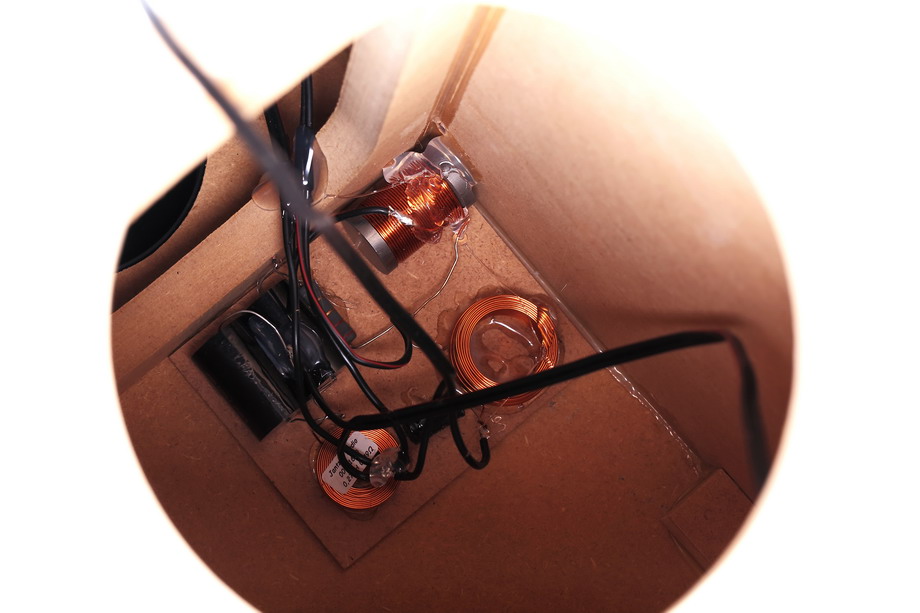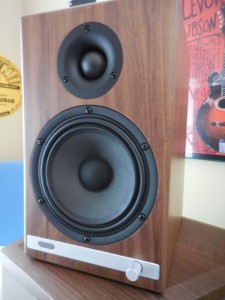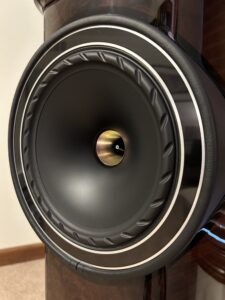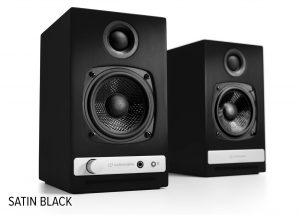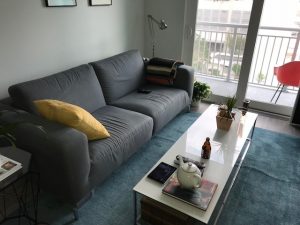Talking only about the price of these speakers, about how impressive product we get for the price, how well it is made—that would be a classic reductionism. Focusing on one feature would suggest its dominance or even lack of other such features that make Pylon Audio Sapphire 25 speakers truly special. And that would be far for truth. When I decided to award them with Best Sound Audio Show 2014 I referred only to the sound quality as in this pretty dark room I couldn't really see much about fit and finish of these boxes, and I learned about their price also only later. Reading now what I wrote in my AudioShow coverage about Pylons, leaving out any false modesty, I might say that I had a correct feeling, correct sense of these speakers.
These are large speakers with great fit&finish factor, three-driver, two-and-half way, floorstanding. They are available in different finishes—both lacquer and veneer—for this test I received a very attractive white finish pair. This product still uses drivers from external vendors - SEAS and Visaton. But as you will find below in a "Few simple words...", Mr Mateusz Jujka, company's director, declares that soon Pylon will release first line of speakers with their own drivers.
A few simple words…
MATEUSZ JUJKA
Pylon Audio | Director
The most important news about Pylon S.A. is that we'll finish all preparations for production of our own drivers this year. This project is conducted in cooperation with an external investor. As a part of this project we have implemented an advanced project an analysis tool from Loudsoft. The same software is used by most prestigious brands around the world. It helped us develop a prototype of our first own transducer, that was later decided to put into production phase. Loudsoft system also helped us to improve already existing quality control procedure for our loudspeakers.
At the same time we have focused our efforts on implementing a production of a new speaker's line—Diamond. This new line is another step that will allow us to offer not only hi fi but also high end products. These new speakers sport drivers from Norwegian SEAS and Danish Scan-Speak. Diamond Line will include two two-and-half-way speakers using 15 and 18 cm mid- lowrange drivers and soft dome tweeters. Both models will be offered with few different finish options: natural veneers and HG.
Our plans for future? We plan to keep modernizing and developing our production lines and to expand further our activity beyond Polish borders. Before the end of this year we plan to release first loudspeakers that will use our own transducers.
The Sapphire 25 premiered during Audio Show 2014. These are 2,5 way speakers. Tweeter comes from SEAS—its a soft dome from Prestige line with a wide, soft polymer surround and a rear chamber with optimal acoustic damping. This particular model sports no magnetic fluid which enhances a reproduction of smallest details and subtleties included in the recording. The midrange and bass are reproduced by a pair of paper cone Visaton W170S woofers. Same drivers are used also in our Topaz line. They offer classic spacial, three-dimensional and particularly dynamic sound, characteristic for this type of cones.
We decided to make Sapphire 25 a 2,5-way design as this allowed for better bass extension and reproduction of unbounded dynamics. Crossover for tweeter sports polypropylene capacitors, the purpose of the whole cabinet design was to make very rigid with minimum damping.At present Sapphire line includes two models: Sapphire 31—a 3-way design and Sapphire 25—a 2,5-way one. We plan to add surround speakers, a central speakers and a subwoofer to complete a Home Theater systems.
SOUND
Recordings used during test (a selection)
- Elvis Presley, Elvis is Back!, RCA/BMG Japan BVCM-37088, "Living Stereo", CD (1960/2002).
- Flairck, De Gouden Eeuw, Bonne Records BOR 96016711, CD (1996).
- Grover Washington Jr., Winelight, Elektra/Audio Fidelity AFZ5 203, "Limited Edition No. 0115", SACD/CD (1980/2015).
- Laurie Anderson, Life on a String, Nonesuch 5979539, HDCD (2010).
- Roy Orbison, Lonely and Blue, Monument Records/Sony Music Japan, SICP-3113, "Roy Orbison Paper Sleeve Collection", CD (1961/2011).
- SBB, Nowy Horyzont, Polskie Nagrania "Muza"/Belle Antique 142218, SHM-CD (1974/2014).
- Shankar, Songs For Everyone, ECM Records ECM 1286, CD (1985/2008).
- Soundgarden, Superunknown, A&M Records 3778183, "Deluxe Edition", 2 x CD (1994/2014).
- The Handsom Family, Singing Bones, Carrot TopSAKI036, CD (2003).
- Thelonious Monk, Solo Monk, Columbia/Music On Vinyl MOVLP843, "Classic Album", 180 g LP (1965/2014).
Whatever you read in this text below, there is one thing you have to know about these speakers—they can easily compete with others that cost 2-3 time more. Pylons don't offer better performance than such competitors and probably you could find some speakers within this price range that in some aspects will offer more, or at least the same level. Audio products are perceived as a sum of their feature, whether we like a particular product or not usually comes from sort of our assessment of pros and cons with our personal preference filter on top—that's what give us our "full picture" of a product. The Sapphire 25 speakers are a very special product as a sum of all pros and cons is absolutely impressive.
A feature, that is hard to find even in more expensive speakers, which is a great "pro" of Pylons, is sound clarity. Large portion of other speakers from up to 10.000 PLN range will be perceived, in comparison, as either muddy or rough. Impressive attack, smoothness of sustain and its precision—all these elements turn each recording into true spectacle. Even such a difficult to reproduce instrument as a grand piano, for example from Solo Monk, sounded particularly well and amazed me with its dynamics. There was no softening of the sound, no rounding of edges—just clarity, dynamics, vibrancy.
Still listening to the same album I realized how rich was the sound delivered by the reviewed speakers. Sapphire 25, despite their large size and two mid-and-low range woofers were tuned in such a way not to use bass as a dominant element of the sound. I'd say that they sounded like large monitors with some extra headroom "behind" the sound, that allowed them to deliver amazingly dynamic performance without any signs of compression, even when I played rock or classical music at high volume levels. The grand piano—let me get back to it for one more second—sounded remarkably convincing in this regard. It was conveyed with depth, in a very orderly way—just as I expected.
It was obvious that these speakers were meant for people (most of potential buyers) who had to place them close to the back wall. When placed close to the wall lower midrange sounded richer, had more "weight". When moved further away from speakers created (as most speakers would) a larger, deeper soundstage, but the range around 200Hz was not as rich as before. This a a very well thought-through design so whichever position is used they sound very good. This is a way for any user to tune Pylons a bit to his/her personal preference. When placed further into the room speakers will deliver a bit "lighter", but not too "light" sound. Put them close to the wall and you'll get a richer, deeper sound but there will be no exaggeration either, sound won't get too "heavy".
The tonal balance of these loudspeakers is set in such a way, that the range between 600-800Hz is most resolving and offers best clarity. It's bit up the range comparing with very rich sounding Castle’s Knight speakers. Model 5 by the same manufacturer offers richer midbass and lower midrange, but it doesn't offer such an amazing clarity and speed a Pylons—there is always some tradeoff. Monitor Audio's Bronze speakers offer similar sound signature as Sapphire, but they lack their dynamics and are not equally resolving.
Polish speakers offer nicely extended bass. If a particular recording, like Laurie Anderson's Life on a String, included very low sounds, these speakers will deliver them with clarity and very good definition, and sound will go as low as needed. Definition and control of the whole low range is very good. More expensive competitors like Dynaudio Excite are able to better define outlines of instruments but they also cost three time more then Polish speakers. What impressed me a lot about Sapphire 25 was an ease they played any music with. They don't offer as much (in a quantitative sense) bass as many other large speakers, but they deliver such a well defined and controlled bass, with such a great clarity that even if you place them close to the back wall to get some more richness of the sound, bass won't become boomy or muddy, it will still be very well defined.
Summary
Speakers from Pylon's Pearl line might be more impressive during first listening session. They seem to offer denser, deeper, more distinct sound. It takes a while to realize that it is not as clear, as dynamic and as a result, less natural, more "tuned". And that's fine if that's how one wants to listen to one's favorite music. But if one requires something more, then Sapphire 25 is a way to go with.
These speakers could easily be the least expensive element of many systems. Or is quite sophisticated systems, for example with Haiku Bright MkIII amplifier and Soul Note SA300 CD Player. Other amplifiers that should deliver exactly what these speakers need are: Advance Acoustic X-i120—richer sound but lesser selectivity—and Clones Audio i25 (it will deliver amazingly rich midrange).
You need to remember that these are quite sophisticated speakers so they require a proper, high quality system to fit in. Give them a chance, choose well accompanying electronics and they will deliver nicely differentiated sound with no coloration that is a curse of most competitors form this price range. One might spend more for other speakers but most likely what one would get would be a different sound signature rather than better performance. It would probably be more reasonable to spend more money to get a better amplifier and/or source.
DESIGN
Sapphire 25 are among very few speakers fully approved by my wife ("finally something different from all these black coffins"), and my son ("they look cool!"). And I agree—good proportions, impressive fit&finish, probably also that damn good looking white lacquer of reviewed pair—all these element made these quite large boxes to blend into to my listening room nicely.
Their cabinets, made of MDF, sport a front baffle with bevelled-edges. Many manufacturers use the same solution, so nothing new here, but in this particular case it simply looks really good. These bevelled-edges close to the floor don't influence sound in any way, but these in two top corners reduce distortion.
Sapphire 25 is a three driver, 2,5-way speaker. They use a very good soft dome tweeter from SEAS - 27TDC, with no magnetic fluid, and two mid- lowrange woofers by Visaton, with one of them placed closely below tweeter. Both are exactly the same model with diameter of 170 mm, both sport paper coated cone and aluminum die-cast basket. The second woofer is placed much lower, closer to the floor level. Company Pylon uses their own markings for both drivers: Pylon Audio PST T-120.6 (tweeter) and Pylon Audio PSW 17-80.8 (woofer).
This is a bass-reflex design with a single port placed on the back of the cabinet. Peaking inside I saw no damping, only some reinforcement to make cabinet more rigid. Even though Sapphire 25 seem inexpensive they are part of the top line of this manufacturer. Manufacturer chose high quality elements for its crossover—polypropylene capacitors and air coils for tweeter section and core coil for bass section.
Crossover uses no PCB—all connections are made point-to-point. It's a more expensive, time consuming method but offering much better results. All cable connections are soldered—again, it's more expensive, but it yields better performance. Manufacturer decided to use OFC internal wire. Instead of cheap, plastic plate with speaker post, manufacturer used a solid, rigid plate with nicely looking posts.
Long adjustable solid steel spikes with metal bases protecting floor are a nice addition. Very good design, executed in amazingly solid and good looking way.
- Parameters (according to manufacturer)
- Nominal impedance: 4 Ω
- Frequency response: 35 Hz-20 Hz
- Nominal power: 120 W
- Max power: 180 W
- Sensitivity: 89 dB
- Dimensions [W x H x D]: 220 x 980 x 360 mm
- Weight: 20 kg/PC
- Woofer: 2 x Pylon Audio PSW 17-80.8
- Tweeter: Pylon Audio PST T-120.6 (Seas 27TDC)
- Warranty: 3 years + 1 year (upon product registration)
Available finishes: black, walnut, wenge, oak, white HG, black HG
Natural veneer: wenge, black, walnut, cherry
Upon order—any RAL color
Price (in Poland): 3000 PLN/pair
Pylon S.A.
ul. Wrocławska 77 | 63-200 Jarocin
Poland
MADE IN POLAND
Text: Wojciech Pacuła
Photos: Wojciech Pacuła | Pylon Audio




